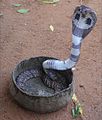The four venomous snake species responsible for causing the greatest number of medically significant human snake bite cases on the Indian Subcontinent (mostly in India) are sometimes collectively referred to as the Big Four. They are as follows:[1][2]
- Common krait, Bungarus caeruleus
- Russell's viper, Daboia russelii
- Indian saw-scaled viper, Echis carinatus
- Indian cobra, Naja naja
Echis carinatus, the saw-scaled viper
Naja naja, the Indian cobra
Of the Big Four, the common krait is responsible for the most snake bites, followed by Russell's viper, the saw-scaled viper, and the Indian cobra.
Treatment
A polyvalent serum that effectively neutralizes the venom of all of the Big Four snakes is widely available in India, and is frequently administered to save lives.
References
- ^ Mukherjee, Ashis K. (2012). "Green medicine as a harmonizing tool to antivenom therapy for the clinical management of snakebite: The road ahead". Indian J Med Res. 136 (1): 10–12. PMC 3461710. PMID 22885258.
- ^ Whitaker Z. 1990. Snakeman. Penguin Books Ltd. 192 pp. ISBN 0-14-014308-4.


_Photographed_By_Shantanu_Kuveskar.jpg)
